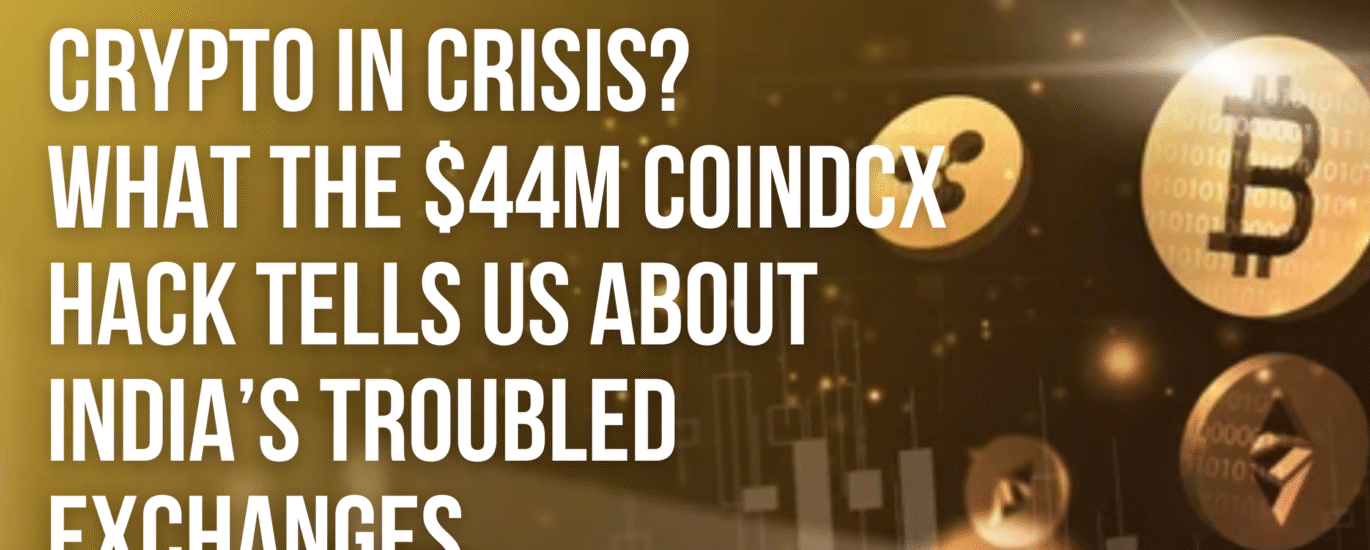If you thought Indian crypto exchanges had learned their lesson after last year’s WazirX cyberattack, think again.
This July, CoinDCX—often touted as one of the most secure and compliant Indian exchanges—fell victim to a sophisticated exploit that siphoned off nearly $44 million in crypto assets from its internal operational wallet. While the loss itself was significant, what sparked even more outrage was how the platform handled it.
The Bigger Problem? Silence.
Despite being a regulated exchange with a massive user base, CoinDCX waited over 17 hours before publicly acknowledging the breach. In the fast-paced world of blockchain, where transactions move in milliseconds and community alerts go viral in minutes, 17 hours feels like an eternity.
By the time CoinDCX released an official statement, blockchain investigators like ZachXBT and on-chain data analysts had already broken the news.
1. What Happened at CoinDCX?
On July 19, 2025, blockchain sleuths noticed large, unusual outflows from a known CoinDCX wallet. These funds were being shuffled rapidly across chains and into mixing services—classic tactics used to obscure the origin of stolen crypto.
CoinDCX later admitted that the funds were drained from a backend operational wallet used for liquidity management, not directly from customer wallets. While the exchange reassured users that their individual holdings weren’t touched, the delay in communication left many questioning whether more damage had already been done—and what else might be hidden.
2. Why This Feels Familiar
Exactly one year ago, Indian crypto exchange WazirX experienced a $230 million cyberattack. That incident triggered a long, public battle over user reimbursements, eventually moving into Singapore’s legal system. A court-mandated vote is now underway to decide whether WazirX users will recover their funds.
So when CoinDCX’s breach occurred almost a year to the day later, many couldn’t help but notice the eerie symmetry.
It begs the question: Is this just bad luck? Or does it point to systemic vulnerabilities within India’s top exchanges—ranging from weak internal protocols to poor communication practices?
3. The Transparency Problem
CoinDCX’s first public message framed the breach as “scheduled maintenance.” It wasn’t until after blockchain analysts and community backlash that the company admitted to the $44 million loss.
That delay raised more than eyebrows. In the traditional financial world, such a breach would legally require disclosure. But in crypto—where regulation is still taking shape—exchanges often operate in a grey area, choosing if and when to be transparent.
This lack of obligation creates a dangerous precedent. If users can’t trust exchanges to report incidents proactively, confidence in the entire ecosystem begins to erode.
4. Can CoinDCX Actually Cover the Loss?
CoinDCX claims it will fully cover the loss using its corporate treasury, not user funds.
On the surface, that sounds reassuring. But users and analysts are asking for on-chain proof: Are there publicly viewable wallets that show CoinDCX has enough reserves? Is there any third-party audit verifying this claim?
Unlike traditional banks, crypto exchanges don’t offer balance sheet transparency unless they choose to. Without verified Proof of Reserves, this promise remains a PR statement—not a guarantee.
5. What Users Experienced
While CoinDCX scrambled internally, users were left in the dark. Many reported:
-
Inability to withdraw funds
-
Delays in support responses
-
Vague, templated replies from the helpdesk
-
Lack of clear timelines or personal account updates
Some turned to social media to vent their frustration. One Reddit user wrote,
“If you can lose millions without telling us, what else don’t we know?”
The sentiment was echoed widely—users don’t just want reassurance; they want evidence.
6. What’s at Stake for Indian Crypto
India is home to over 20 million crypto users—most of them retail investors who use platforms like CoinDCX and WazirX for everyday trading and savings.
These back-to-back hacks don’t just spook users. They also:
-
Drive away institutions who might have considered entering India’s crypto markets
-
Slow down innovation, as startups become wary of entering a volatile space
-
Invite stricter regulation, especially from the RBI and enforcement agencies
-
Hurt public sentiment, especially among new investors who already view crypto as risky
In short, every hack becomes an industry-wide credibility hit—even if only one exchange is involved.
7. What Can Users Do?
In an ecosystem where “not your keys, not your crypto” still holds true, users need to take proactive steps:
-
Demand Proof of Reserves: Ask your exchange to publish on-chain audits.
-
Watch for Red Flags: Sudden “maintenance,” withdrawal delays, or vague emails are warning signs.
-
Diversify Platforms: Don’t store all your funds on one exchange.
-
Use Cold Wallets: For long-term savings, move your crypto to a hardware wallet where you hold the keys.
Crypto is built on decentralization—but it only works if users stay informed and involved.
8. Where Regulators Stand
India’s regulatory landscape for crypto remains ambiguous. The Finance Ministry has acknowledged the need for guidelines, but progress has been slow.
Events like the CoinDCX hack may finally tip the scales toward more formal disclosure laws, mandatory insurance pools, or real-time auditing frameworks. But whether regulators act—or continue to treat crypto as a grey zone—remains to be seen.
In the meantime, users are left to fend for themselves in an industry that preaches decentralization, but often relies on centralized exchanges.
Closing Thought
The CoinDCX hack is more than a technical issue—it’s a trust issue.
In a decentralized economy, trust is built through transparency, not silence. Indian exchanges must move beyond PR spin and deliver timely, verifiable information when things go wrong. That means admitting breaches early, proving financial backing publicly, and engaging users with clarity.
Until that happens, Indian crypto users will remain on edge—wondering if the next breaking news will involve their funds.
And when trust breaks, the users don’t just walk away.
They take their wallets with them.






